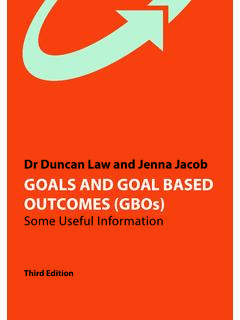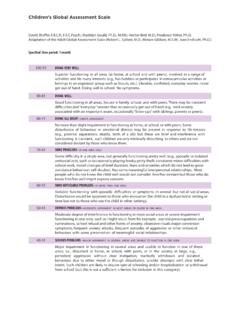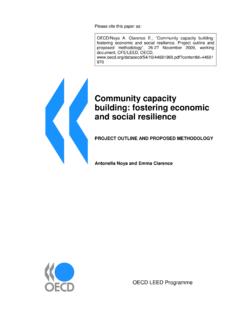Transcription of Wellbeing Measurement Framework for Primary Schools
1 Wellbeing Measurement Framework for Primary Schools In partnership with Child Outcomes Research Consortium CONTENTS. About the Wellbeing Measurement Framework for Primary Schools 3. Me and my feelings (M&MF) 4. Students' Life Satisfaction Scale (SLSS) 5. Student resilience Survey (SRS) 6. Useful reading 9. The measures included in this booklet are suggestions for age-appropriate measures to use with Primary school children. Please note: This booklet is for reference use and information only. It is not intended for the survey to be completed in this booklet format. ABOUT THE Wellbeing Measurement . Framework FOR Primary Schools . What is it? How it was developed A set of questionnaires which can be used to The questionnaires have been chosen to measure measure Wellbeing and resilience in children and key aspects of Wellbeing and resilience . young people. The original set of questionnaires was How it works co-produced with project leads who are part of HeadStart, a programme trialling a range of The questionnaires are completed by students initiatives for improving resilience in 10 16 year online (generally annually).
2 Olds, funded by the Big Lottery. In this booklet a brief overview of each questionnaire is provided, as well as a full list of Future use items, details of subscales and response options. The questionnaires: The aim is that Schools can use some or all of the questionnaires included in this survey and add Are suitable for a reading age of 9 11 years old other questions as relevant to their context. and are possible to complete during a lesson Include a balance of positively and negatively For more information, contact: worded questions Are considered to have acceptable psychometric properties ( they are reliable, valid and sensitive to change). Why it's helpful Students' responses to the questionnaires: Provide a snapshot of the strengths and challenges students are facing, which can be used to target support Help Schools to evaluate their interventions Send a positive message to parents and carers that the school is focused on students' Wellbeing .
3 3 Wellbeing Measurement Framework for Primary Schools ME AND MY FEELINGS. Below is a questionnaire which is going to ask you how you feel. There are no right or wrong answers. You should just pick the answer which is best for you. Statement Never Sometimes Always I feel lonely I cry a lot I am unhappy Nobody likes me I worry a lot I have problems sleeping I wake up in the night I am shy I feel scared I worry when I am at school I get very angry I lose my temper I hit out when I am angry I do things to hurt people I am calm I break things on purpose Thank You! Deighton, Patalay, Vostanis, Tymms, Humphrey, Belsky, Wolpert and Fonagy 4 Wellbeing Measurement Framework for Primary Schools STUDENTS' LIFE SATISFACTION SCALE. We would like to know what thoughts about life you have had during the past several weeks. Think about how you spend each day and night and then think about how your life has been during most of this time.
4 Here are some questions that ask you to indicate your satisfaction with your overall life. Tick the box next to each statement that indicates the extent to which you agree or disagree with that statement. It is important to know what you REALLY think, so please answer the questions the way you really think, not how you should think. This is NOT a test. There are NO right or wrong answers. strongly moderately mildly mildly moderately strongly statement disagree disagree disagree agree agree agree My life is going well My life is just right I would like to change many things in my life I wish I had a different kind of life I have a good life I have what I want in life My life is better than most kids Huebner, E. S. (1991). Initial development of the Students' Life Satisfaction Scale. school Psychology International, 12, 231 243. Are you or have you ever been a young carer? Young carers are children and young people under 18 who provide regular or ongoing care to a family member who has an illness, disability, mental health condition or drug/alcohol dependency.
5 Yes No 5 Wellbeing Measurement Framework for Primary Schools MEASURES OF MECHANISMS. SUPPORTING GOOD OUTCOMES. STUDENT resilience SURVEY (SRS). Please read every statement carefully and circle the answer that fits you best. at home, there is an adult never always .. is interested in my school work 1 2 3 4 5.. believes that I will be a success 1 2 3 4 5.. wants me to do my best 1 2 3 4 5.. listens to me when I have something to say 1 2 3 4 5. at school , there is an adult never always .. really cares about me 1 2 3 4 5.. tells me when I do a good job 1 2 3 4 5.. listens to me when I have something to say 1 2 3 4 5.. believes that I will be a success 1 2 3 4 5. away from school , there is an adult never always .. really cares about me 1 2 3 4 5.. tells me when I do a good job 1 2 3 4 5.. believes that I will be a success 1 2 3 4 5.. I trust 1 2 3 4 5. 6 Wellbeing Measurement Framework for Primary Schools away from never always.
6 I am a member of a club, sports team, church 1 2 3 4 5. group, or other group .. I take lessons in music, arts, sports, 1 2 3 4 5. or have a hobby are there students at your school who never always .. choose you on their team at school 1 2 3 4 5. tell you you're good at doing things 1 2 3 4 5.. explain the rules of a game if you didn't understand them 1 2 3 4 5.. invite you to their home 1 2 3 4 5.. share things with you 1 2 3 4 5.. help you if you hurt yourself 1 2 3 4 5.. miss you if you weren't at school 1 2 3 4 5.. make you feel better if something is bothering you 1 2 3 4 5.. pick you for a partner 1 2 3 4 5.. help you if other students are being mean to you 1 2 3 4 5.. tell you you're their friend 1 2 3 4 5.. ask you to join in when you are all alone 1 2 3 4 5.. tell you secrets 1 2 3 4 5. 7 Wellbeing Measurement Framework for Primary Schools never always I do things at home that make a difference 1 2 3 4 5.
7 ( make things better). I help my family make decisions 1 2 3 4 5. At school , I decide things like class activities or rules 1 2 3 4 5. I do things at school that make a difference ( make things 1 2 3 4 5. better). I can work out my problems 1 2 3 4 5. I can do most things if I try 1 2 3 4 5. There are many things that I do well 1 2 3 4 5. I feel bad when someone gets their feelings hurt 1 2 3 4 5. I try to understand what other people feel 1 2 3 4 5. When I need help, I find someone to talk to 1 2 3 4 5. I know where to go for help when I have a problem 1 2 3 4 5. I try to work out problems by talking about them 1 2 3 4 5. I have goals and plans for the future 1 2 3 4 5. I think I will be successful when I grow up 1 2 3 4 5. 8 Wellbeing Measurement Framework for Primary Schools USEFUL READING. ME AND MY FEELINGS. Deighton, J., Tymms, P., Vostanis, P., Belsky, J., Fonagy, P., Brown, A., Martin, A.
8 , Patalay, P. & Wolpert, W. (2013). The development of a school -based measure of child mental health. Journal of Psychoeducational Assessment, 31(3), 247 257. Wolpert, M., Deighton, J., Patalay, P., Martin, A., Fitzgerald, , Demir, E.,..Meadows, P. (2011). Me and My school : Findings from the National Evaluation of Targeted Mental Health in Schools 2008 2011. (Research Report DFE-RR177). Retrieved from uploads/system/uploads/attachment_data/f ile/184060 STUDENT LIFE SATISFACTION SCALE. Huebner, E. S. (1991). Further validation of the students' life satisfaction scale: The independence of satisfaction and affect ratings. Journal of Psychoeducational Assessment, 9(4), 363 368. Huebner, E. S. (1991). Initial development of the Students' Life Satisfaction Scale. school Psychology International, 12(3), 231 243. STUDENT resilience SURVEY. California Department of Education. (2004). California Healthy Kids Survey.
9 America: California Safe and Healthy Kids program office. Ladd, , Kochenderfer, B. J., & Coleman, (1996). Friendship quality as a predictor of young children's early school adjustment. Child Development, 67, 1103 1118. Lereya, , Humphrey, N., Patalay, P., Wolpert, M. B hnke, , Macdougall, A., & Deighton, J. (2016). The Student resilience Survey: psychometric validation and associations with mental health. Child and Adolescent Psychiatry and Mental Health, 10(44), 1 15. Sun, J. & Stewart, D. (2007). Development of population-based resilience measures in the Primary school setting. Health Education, 107(6), 575 99.












